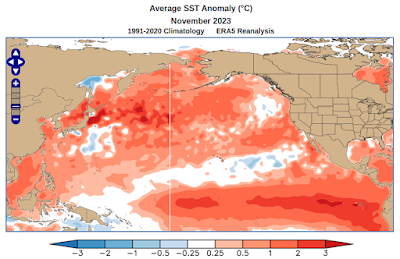Objective Comments and Analysis - All Science, No Politics
Primary Author Richard James
2010-2013 Author Rick Thoman
Wednesday, December 27, 2023
Cold At Last
Wednesday, December 20, 2023
AI Forecast Follow-Up
Last month I penned a few comments on the big news in the weather industry: the emergence of AI models as a legitimate competitor to traditional physics-based models for weather forecasting.
To provide a more concrete example of the impressive performance of the new models, I pulled out forecasts for Fairbanks from two of the AI models that I've been running over the past couple of months. Note how remarkable this is: the models can be run on pretty modest hardware; you don't need a supercomputer.
Here's a basic comparison of forecast skill for days 1-14 of the 2m temperature forecasts for Fairbanks (click to enlarge). Here I'm using ERA5 reanalysis data as "ground truth".
The two AI models are GraphCast (Google) and FourCastNet (NVIDIA), and I'm running FourCastNet with 50 members based on the initial conditions in the ECMWF ensemble forecast. GraphCast is more computationally demanding, so I only have a single member each day. The usual (traditional) ECMWF and GEFS ensembles have 51 and 31 members respectively.
Remarkably, GraphCast's single forecast member equals the ECMWF ensemble skill out to 9 days. The ECMWF ensemble is the gold standard for medium-range forecasting, so this is a terrific result that confirms the power of the new models. In contrast, FourCastNet starts out strong but roughly equals GEFS after 5 days, with inferior skill. Note that systematic bias could affect these results to some extent, as I used the ERA5 seasonal normal as the baseline, without any bias correction.
Looking at the mid-atmosphere 500mb height forecasts, it's interesting to note that GraphCast drops off significantly after 10 days, while FourCastNet shows a very strong performance. This may be reflecting the benefit of an ensemble approach for the medium-range (7-14 day) forecast.
More results will be forthcoming when I have time. In the meantime, here's the latest forecast I have access to: the message is "warmer than normal" in Fairbanks, and perhaps especially around Christmas Eve and New Year's Eve.
The CPC's 8-14 day forecast also calls for warmth for central and eastern Alaska around the New Year period. It's a very typical El Niño pattern nationwide.
Thursday, December 14, 2023
Stormy Weather
The last few days have brought wild weather to large parts of Alaska, courtesy of a very powerful upper-level trough and associated low pressure system over the northern Gulf Coast. Anchorage received measurable snow for 7 days in a row, with a total of almost 20", and that's enough to put them in first place for season-to-date snowfall at this point in the year.
Not surprisingly, the surface pressure analysis on Tuesday afternoon looked very similar to that from about a month ago, when Anchorage received its really big snow storm: the low center was a hundred miles or so to the southeast of the city.
Compare to the November 9 map posted here:
https://ak-wx.blogspot.com/2023/11/south-coast-snowstorm.html
The 500mb map from the same time on (this) Tuesday afternoon shows the mid-atmosphere trough in all its glory:
The eastward "tilt" of the trough at lower latitude is characteristic of particularly strong storm systems with a lot of upper-level "energy". The sub-500 dm height at Anchorage (499dm to be precise) is notably low: about a third of winters in recent decades haven't seen a 500mb height that low all winter.
Here's an estimate of 3-day total liquid-equivalent precipitation, and the second map below indicates the estimated return frequency: over 5 years in parts of the higher terrain from the northern Panhandle up towards the Alaska Range.
The Fairbanks area received a significant snowfall, with a surprisingly large precipitation total of 0.54" (liquid equivalent) in the last 2 days (Tuesday and Wednesday). I say "surprisingly" because temperatures were fairly low, only peaking at 10°F and 7°F on the two days respectively, and the snow:water ratio was an unusually low 11:1. About 50% of winters in Fairbanks don't see a single 2-day precipitation event as large as this - although it has become more common in recent years.
Finally, the big pressure gradients associated with the broader circulation anomaly also generated big winds, especially for the West Coast, where the winds were northerly and created blizzard conditions. Here are peak wind gusts (mph) for Monday and Tuesday.
Sadly the weather appears to have been a contributing factor in the deaths of two Nome residents on Sunday night:




























